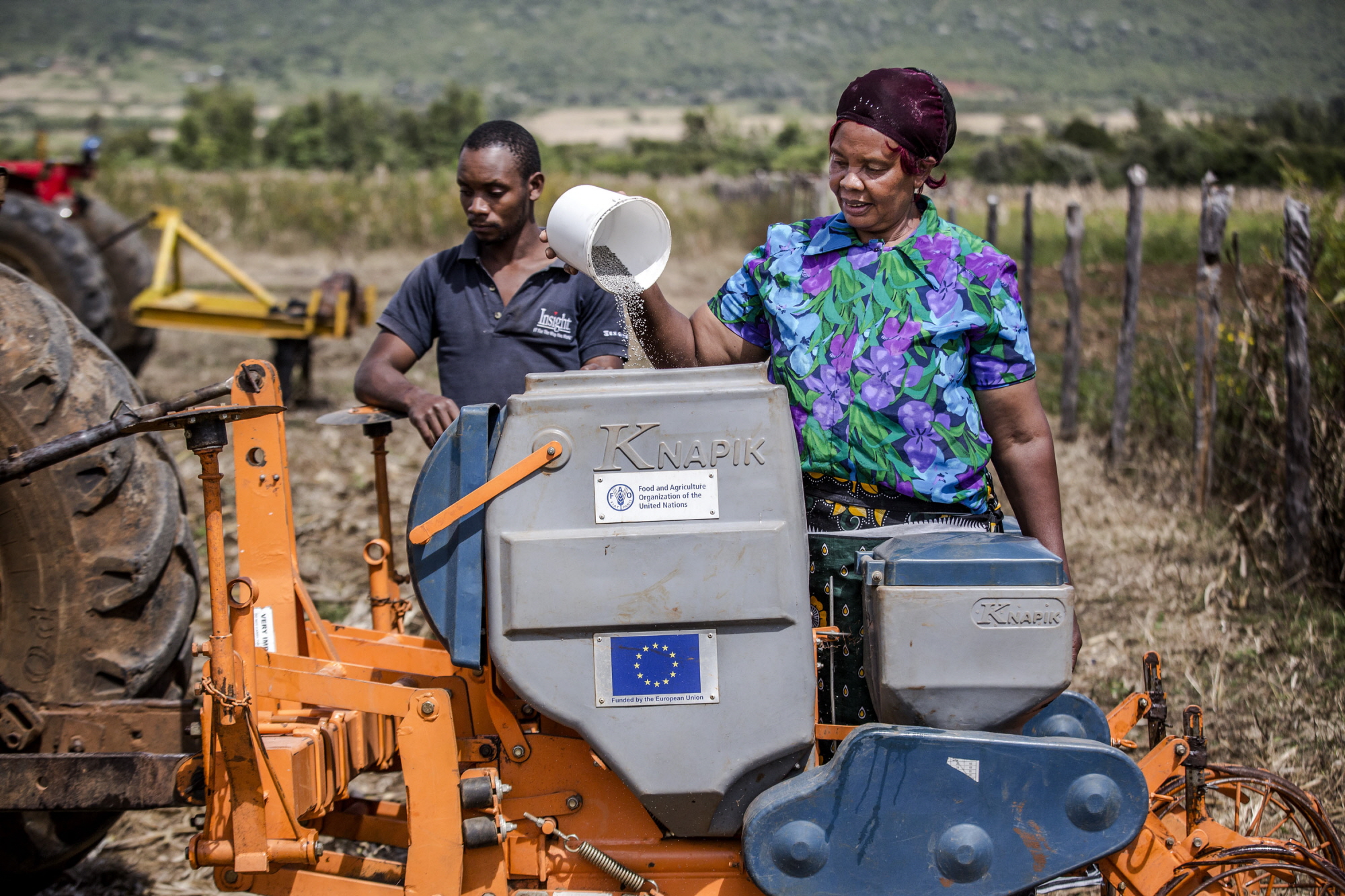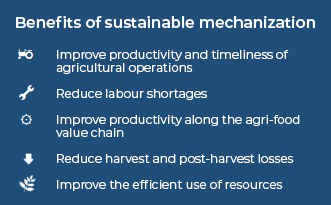Getting down to the nuts and bolts – a push for sustainable agricultural mechanization in Africa
 ©FAO/Luis Tato - Miriam Mbuki Koigu, farmer and beneficiary of FAO's Mechanization Programme for Conservation Agriculture Farmers
©FAO/Luis Tato - Miriam Mbuki Koigu, farmer and beneficiary of FAO's Mechanization Programme for Conservation Agriculture FarmersToday, more than ever, digital agriculture is streamlining efficiency and productivity. But in Africa, many people do not have access to agricultural tools and equipment to improve their yields and reduce heavy labour. These tools, digital and non-digital, need to be available to farmers.
“Agricultural mechanization and innovation need to be part of the equation,” says Josef Kienzle, an agricultural engineer and leader of FAO’s mechanization task team.
FAO is supporting the African Union to promote sustainable agricultural mechanization across the continent to boost agricultural productivity and production with a view to ending hunger in Africa by 2025 and feeding a growing and rapidly urbanizing population.
Around 60 percent of Africa’s population earns a living from agriculture, but the sector is failing to reach its potential. Sustainable mechanization – from simple hand tools to more sophisticated and motorized equipment – not only can improve productivity along the agrifood value chain but also reduce harvest and post-harvest losses. It can ease the burden of hard physical work, reduce labour shortages and improve the productivity and timeliness of agricultural operations. And it can lead to better market access by improving food quality and safety, added value, logistics and transportation.
Small-scale farmers cannot always afford to buy agricultural machinery. Thus, being able to rent mechanization services to prepare land for early planting or for on-time harvesting is key.
Mobile phone technologies combined with GPS tractor trackers have become new business models. The TROTRO Tractor Limited, for example, is a powerful platform that connects farmers and tractor operators, helping to improve accountability and reduce the loss and misuse of equipment. It operates in Ghana and Zimbabwe and soon in Kenya.
At the request of the African Union and FAO Member Countries, FAO developed the Sustainable Agricultural Mechanization: A Framework for Africa with the Department of Rural Economy and Agriculture of the African Union Commission. The comprehensive framework, the product of a long, Africa-wide consultative process, provides guidance on tackling challenges and promoting greater uptake of sustainable mechanization.
To carry out the framework’s recommendations, FAO’s Investment Centre and Plant Production and Protection Division jointly organized regional workshops in Côte d’Ivoire (with around 30 representatives from Benin, Senegal, Morocco, Burkina Faso, Côte d’Ivoire), and in Uganda (with more than 60 representatives from Ethiopia, Kenya, United Republic of Tanzania, Zambia, Ghana, Uganda). The workshops brought together practitioners, government officials, farmer organization representatives and bankers to share experiences and knowledge. They looked at the need to link good agronomic practices, like Conservation Agriculture, with sustainable mechanization options.
“Mechanization is not about displacing labour or pushing industrial agriculture,” according to Kienzle. “It’s about boosting farm power through technologies that are environmentally, economically and socially sustainable.” That means promoting climate-smart technologies that are appropriate, readily available and affordable. These technologies should target women as well as young farmers and rural entrepreneurs by creating attractive jobs in agriculture.
Kouamé Samuel, an FAO workshop attendee from Côte d’Ivoire, reported that his enterprise’s vision was to “place agricultural technologies at the service of farmers to boost their productivity and sustainability."
Sustainable agricultural mechanization is largely driven by the private sector. Finding the right business models is vital. Public–private dialogue, including with farmers’ organizations, is also key for creating an enabling policy environment and building trust.
“We need accurate trade data on sustainable agricultural mechanization from the public and private sectors to better judge where the needs are,” Kienzle says. “We also need to have Africa-wide standards and certification schemes in place to guarantee the quality and safety of agricultural equipment. This would help with its trade.”
FAO Investment Centre Africa Service Chief, Alberta Mascaretti, says that the Centre stands ready “to facilitate work with our partners to help finance sustainable agricultural mechanization in Africa and to promote technology and business models adapted to smallholder farmers and small and medium enterprises along the value chain.” She adds that “special attention should be given to reducing the drudgery of many agricultural and domestic tasks for women.”
The framework serves as a common long-term vision for African countries on policy and strategy. It also creates a foundation for regional cooperation, networking and partnerships. The European Agricultural Machinery Industry Association, for example, is urging the European Commission to mainstream sustainable agricultural mechanization in Africa into its new strategy.
Sustainable mechanization will contribute to greater food security at the farm level and improve efficiencies throughout the food value chain across the African continent.

